by Charles Carreon
July 24, 2019
It’s impossible to see yourself when you’re cocooned inside a rosy glow of nostalgia, so the Shambhala insiders who appear in “Crazy Wisdom” look very comfortable and somewhat pathetic.
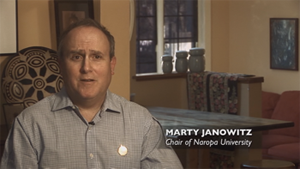
In this slick biopic lionizing the dead Chogyam Trungpa from the safe distance of a few decades, Trungpa’s core followers appear like a string of lottery winners dressed in casual formal attire, comfortably seated in cozy sitting rooms, tasteful meditation halls, traditional shrines, and art studios. Each lucky man or woman presents the same aspect – supremely satisfied with their decision to devote their lives to Trunpa’s vision; firmly grasping the brass ring they were so fortunate to clasp when Trungpa held it out to them; serene in the knowledge that they made the right choice when they delivered their life into his hands; happy singing hosannas forever to Trungpa, Trungpa, Trungpa!
Presented in a haze of perfection, this string of Trungpa worshippers presents like a necklace of matched, cultured pearls – each one expressing identical sentiments, venturing nothing surprising, unique, or individual. Their adulation comes from a factory with faultless quality control. Their very sincerity seems affected. They’ve become the Martha Stewarts of spirituality, offering a safe, respectable approach to inner growth and fulfillment. Nevertheless, this film cannot whitewash the tainted legacy of a man whose greatest skill was his practice of self-deception. What “Crazy Wisdom” will do is memorialize the naivete, blindness, and complicity of those who, seduced by Trungpa’s self-love, still serve his will, emulating his enigmatic poses and pregnant pauses as they gush praise, elide the truth, and distort reality, painting a picture of a spiritual Camelot that never was. “Crazy Wisdom” is a farcical re-imagination of a life marked by chaotic misconduct, florid self-aggrandizement, and canny manipulation as a stately progression from sainted birth, through heroic adolescence, to fruitful maturity, culminating in nirvana, crowned by canonization, his sainthood confirmed by meteorological displays of celestial glory. There’s more truth to be found in Disney’s Snow White.
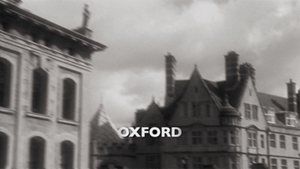
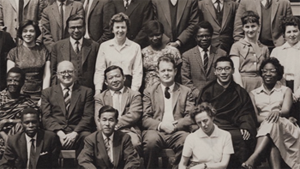
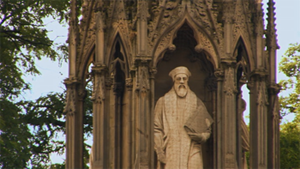
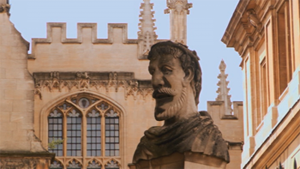
Most notable about “Crazy Wisdom” is the scenes that aren’t included. We don’t see the classrooms at the unnamed Oxford College that Trungpa likely never attended (there are currently 39 Oxford colleges), or hear from his teachers or fellow-students. Rather, over the rooftops of a quaint English town, the single word “Oxford” appears onscreen, followed by “1963 Chogyam Trungpa receives a grant to study in England,” a group photo of college-age people among which Trungpa’s appears as the only Tibetan face, and static shots of medieval saints carved in stone.
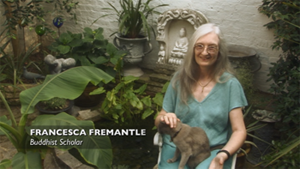
Following this suggestive but factually substanceless montage, a trio of acolytes offer bland speculations about what Trungpa was up to during his early years in England. Francesca Freemantle, a silver-haired academic, says “He was going through a period of really examining how he was going to teach.”
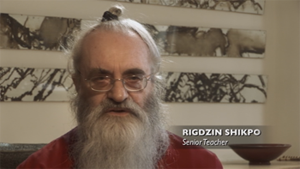
Rigzin Shipko, a graying English yogi, claims “Rinpoche was doing various courses in order to familiarize himself with Western culture.”
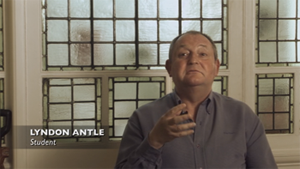
Lyndon Antle, who claims that, after seeing Trungpa once in the Telegraph newspaper, he sold his house, quit his job, and made the trip to Samye Ling on public transport, walking the last 17 miles to the remote location near Eskdalemuir, credits Trungpa with “trying to gather the experience directly for himself of the suffering of the human condition in the west.” And that’s it for Trungpa’s attendance at England’s most prestigious institution of higher learning.
We don’t see the bedroom at Garwald House where Diana Pybus, all of sixteen and a week, climbed into Trungpa’s bed to aid his recovery from his crippling accident. We don’t hear about how the two were jailed for a night after skipping out on a hotel bill after a frolic in Glasgow. We never hear how Pamela and Christopher Woodman, devoted students scandalized by Trungpa’s habitual drunkenness and his marriage to Diana, over fourteen years his junior, accused him of moral turpitude to the American immigration authorities.
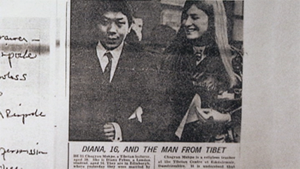
We are briefly shown a tabloid headline trumpeting the marriage to the British public, which became notorious as one of the first marriages of a sixteen-year-old bride pursuant to a change in English law. We do not hear about how the marriage outraged Diana’s family, causing her Uncle Michael to loudly accuse Trungpa in a public house as “a cradle robber and a baby snatcher” who would be wise to “go to America, because anything goes there.”
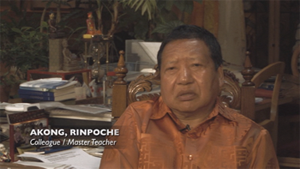
Although Akong Tulku appears in the movie, he says nothing about how he ostracized Trungpa at Samye Ling for being an embarrassment to the Kagyu lineage, or how Trungpa retaliated against him by destroying his personal shrine, urinating on the staircase, and passing out in his own filth, all on a special day when donors were present for a special visit to the abbey. Neither does Akong tell us how he was so eager to see the pair gone that he loaned Trungpa the money to fly to America, and so distrustful of repayment that he demanded custody of the ancient Trungpa lineage seals as collateral for the loan. We don’t learn that Trungpa flew to the USA without a visa, and had to wait for several months to get one, because the Americans cancelled his visa due to the accusations made by the Woodmans. We don’t hear about how Trungpa and Diana were turned out of the home of a Korean monk, Samu Kim, from whom they initially received a warm welcome, after one night of drinking. Apparently not having the requisite ability to reinterpret Trungpa’s rough behavior as crazy wisdom, Samu asked him to leave, explaining that, “You look like a Buddha, but you’re just an ordinary man. You look the story, you walk the story, but you’re not the real thing. You can’t stay any longer.”
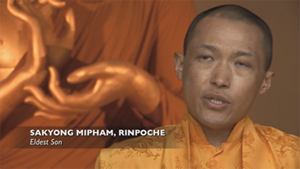
Trungpa’s son, Osel Mukpo, aka “the Sakyong,” appears to speak a few ambiguous words about his father, but we never see the “Lady Konchok,” the Tibetan nun upon whom Trungpa sired the child, then abandoned in India. Osel doesn’t tell us how he felt about being taken from his mother, transported to Samye Ling at the age of seven, and left without family to care for him when Trungpa and Diana decamped for the States. We do not hear from Pamela and Chris Woodman, who gave Osel a home and cared for him for over a year before Trungpa filed a custody lawsuit to take him from them. Osel doesn’t tell us about the two years he spent at the Pestalozzi Village, an orphanage for refugee children, after being taken from the Woodman home by means of legal process, while barristers and solicitors sorted his fate. Nor does he tell us how he felt about his absentee father, who made his presence felt primarily by means of custody litigation while he drank, wrote poetry, and seduced his students in Vermont and Colorado. Osel doesn’t tell us how, the one time Trungpa came to see him in England, he experienced little more than fear of the stranger who was his father.
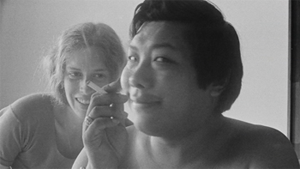
Several of the people interviewed in the film were present at the drunken Halloween party where Trungpa ordered the most aggressive males in his devotion-addled cult to break into the bedroom of a famous poet and his girlfriend, and drag them downstairs to participate in the festivities, where Trungpa, lording it over the fawning crowd like a Buddhist version of Jabba the Hutt, had the couple stripped naked for his entertainment. However, not one of these well-scrubbed, well-respected teachers of American Dharma breathes a word about this event.
We don’t meet any of Trungpa’s seven wives, who kept many nasty secrets about him hidden – his ultra-secret cocaine addiction, his penchant for torturing animals, his indulgence in sex with underage girls. We don’t hear about Trungpa’s tragic marriage to Ciel Turzanski, his sixth wife, whom he “married” the day she turned eighteen, after what all presume was a five-year long affair between the two. We aren’t so much as shown a photograph of this sacrificed child bride, who committed suicide many years later, a victim of torments too painful to imagine.
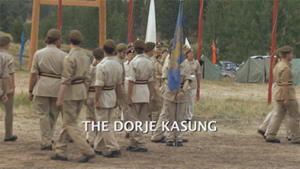
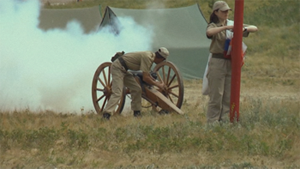
The movie paints a friendly face on this sexual predator. We see the “Dorje Kasung,” Trungpa’s vajra guard, marching in uniform, and hear unctuous explanations about how putting Dharma nerds in uniform integrates worldly and spiritual life in “enlightened society.” However, none of these Kasung tell us that they really served as vajra pimps, bringing him the wives and girlfriends of his male students as sexual offerings, breaking up families, poisoning conjugal relationships, and preying on the daughters of students too young to lawfully consent to sexual relations.


Two middle-aged Dharma matrons appear to declare the transcendent nature of their trysts with the tantric master.
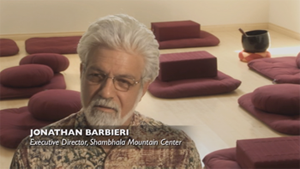
A cuckold declares that he was jealous – of his wife’s relationship with Trungpa! He wished he could get that close!
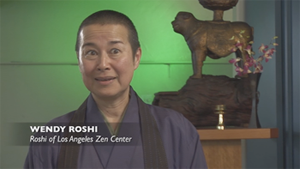
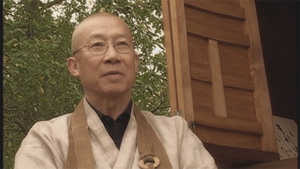
Lest anyone think that only Trungpa’s students are able to see the saint behind the sins, Wendy Roshi of Los Angeles Zen Center shows up to laud the “openness” with which he carried on his dalliances, and Kwong Roshi of Sonoma Mountain Zen Center comes close to tears recalling how Trungpa cried at Suzuki Roshi’s funeral.
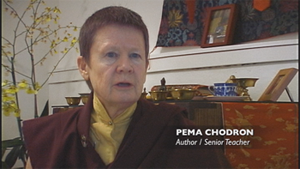
Still, when it comes to modeling innocent befuddlement at how Trungpa could indulge in such extensive bad behavior while engaging in a religious mission, Pema Chodron sets the gold standard. Claiming that she just “does not know” how to reconcile the conflicting facts, she delivers dumb looks with panache, equating ignorance with wisdom. It is all a clever dodge, however. When she says she “doesn’t know,” she conceals that what she really means is that she is so convinced of Trungpa’s sanctity that nothing he did could ever shake her faith in his perfection. Like a Trumper who would excuse the Donald of homicide if he shot someone on Fifth Avenue, Pema Chodron won’t be budged from her commitment to Trungpa’s divinity, regardless of the evidence. For her to claim that this is a “suspension of judgment” or an “inability to reach a conclusion” is mere sophistry, devoid of sincerity.
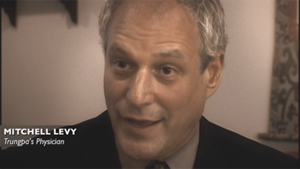
Trungpa’s bizarre family life is of course off limits. We hear some “secular spiritual” mumbo-jumbo from the lips of Dr. Mitchell Levy, the Doctor Feelgood who allowed Trungpa to drink and drug himself into an early grave: “He taught by being a human being. He never said, ‘follow me, imitate me.’” What Dr. Levy doesn’t tell us is that, when Trungpa cast Diana aside to engage in sex with everyone else with tits inside grabbing range, he made himself useful by becoming Diana’s lover. Nor does Dr. Levy tell us that “Ashoka Mukpo” who passes in the press for Trungpa’s son, is actually his own child, born to Diana -- a Jewish-British Buddhist boy who got stuck with a Tibetan name. There are of course advantages to this arrangement, because Ashoka was recognized as a tulku, even though not born of Trungpa’s seed.
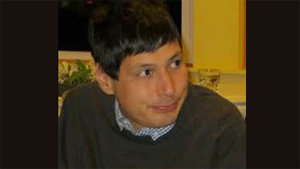
Ashoka would really have little to complain about, because Trungpa’s seed may not have been the safest genetic line to spring from. Taggie, the eldest son of his union with Diana, suffers from severe autism, and is not featured in the movie at all, even though he was recognized by the Sixteenth Karmapa as a tulku. Although autistic children benefit from sensory therapy, speech therapy, and music therapy, Taggie received none of these. Indeed, he didn't even receive basic home care, or parental affection. At age six, he was interned in the Karmapa's Rumtek monastery, and didn't return to the United States until he was eighteen. Since then, Taggie has been in the care of third parties in separate housing, due to his proclivity for violent rages and other dysfunctional behavior. One of Taggie’s longtime caretakers, Christine Chandler, in her book about the thirty years she spent in the Mukpo family cult, explained that what most enraged Taggie was the endless procession of fawning Trungpa students who, believing him to be a tulku, sought to indulge his every whim, thus stimulating his worst behavior. As Chandler recounts, Diana visited Taggie only once in over six years. On another occasion, his brother Osel promised to come for a visit, and although he never arrived, the newsletter for the Karme Choling retreat center joyfully published a report about "what a wonderful visit the Sakyong had with his brother." Chandler also describes how everyone, from Trungpa disciples to visiting lamas, seemed eager to project their fantasies on the disabled youth, variously believing him to be an embodiment of crazy wisdom, possessed by a demon, or merely in need of "a female consort." Since the movie fails to make any mention of Taggie's existence, of course, it conveniently avoids the fact that the Mukpo family, known for its extravagant spending on luxuries, has shifted the cost of Taggie's home care to the state of Vermont. Thus, disowned in body and spirit, cared for by strangers at the expense of the state, Taggie's origins as Trungpa's son appear to have benefited him not at all. While it would take a DNA test to gather the necessary evidence, modern medicine tells us that fetal alcohol syndrome often results from paternal alcohol abuse, so Taggie may have more than tulku status to thank his father for.
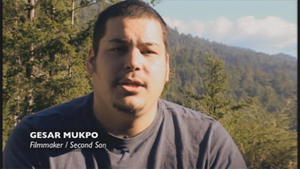
Gesar Mukpo, the youngest son of the Trungpa/Diana union, is another incarnate Bodhisattva, due to the now-obligatory practice of recognizing the fruit of all lama-seed as sacred. Gesar appears briefly in the movie, designated as a “filmmaker,” despite having only one film to his name, a one-hour production entitled “Tulku,” in which he interviews a number of young men who, like himself, have been recognized as incarnate Bodhisattvas, but can’t quite seem to get the hang of the family business. Gesar rejects the opportunity to share reminiscences about his famous father, deflecting an inquiry about whether Trungpa showed him love: “Love? Talking about love is an insult sort of to our relationship, because it was like he treated me like the reincarnated lama that I was recognized as. So in terms of love, did we ever talk about love – there was never any talk about something like that. He treated me like he would have treated a king of another country, you know?”
One of the most tragic episodes in the history of Trungpa’s “enlightened society” goes entirely unmentioned in the movie -- Trungpa’s terrible choice of a successor to run his organization -- Thomas Rich, that some stalwarts still venerate as “Osel Tenzin, the Vajra Regent.” Rich, whose feckless indulgence in unprotected sex while infected with HIV claimed the lives of at least two people, and probably more, has been disappeared altogether. This keeps us far away from the dangerous fact that Trungpa apparently knew that Rich had AIDS, and discouraged him from disclosing it to his sexual partners or using a condom, giving Rich license to commit heinous crimes that are now recognized as murder, plain and simple. But for those who watch “Crazy Wisdom” without knowing the story behind the lies, the concealment of Rich’s misdeeds is as complete as a bricked-over passageway to a room that has been erased from the floor plan.
Although it is well-known that Trungpa’s death was preceded by a long decline during which he lost control over his bodily movements, becoming totally reliant on personal aides to maintain his appearance and manage personal life activities, we see nothing of this. “Crazy Wisdom” sanctifies Trungpa’s early death due to alcohol and drug toxicity at the age of 48, by avoiding all discussion of the months during which his ravaged body was maintained in a semi-comatose state by the use of extraordinary medical procedures at the behest of students unable to come to grips with Trungpa’s untimely passing.
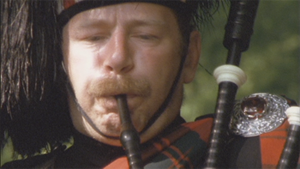
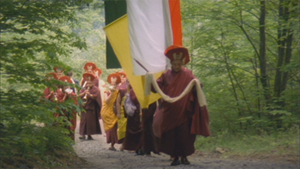
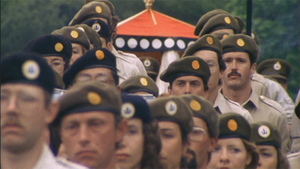

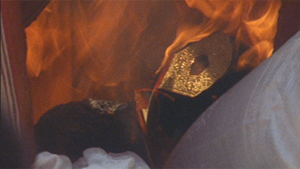
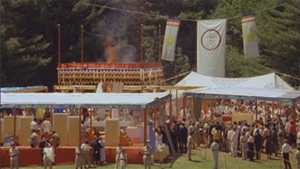
The movie announced his death as a historical fact, then segues into the gala cremation ceremony in a vast green field thronged with followers, presided over by crowds of traditionally-garbed Tibetans, led by the redoubtable Dilgo Khyentse, whose mere face is sufficient to reduce the devoted to sighs of awe. We see the uniformed pallbearers, numbering about a dozen, carrying his remains in a brocaded palanquin to the funeral chorten, where they are consumed in a splendid conflagration, flames spouting from the roof in a micro-inferno of sacralized fire.
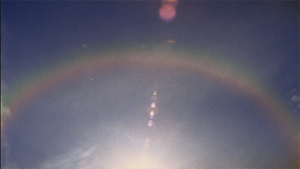

The event is crowned with “fire rainbows,” an atmospheric phenomenon scientifically known as a “circumhorizontal arc” that can occur when the sun is at an elevation of 58° or greater and sunlight enters high altitude cirrus clouds at a specific angle. Like many other folks with cameras, the filmmakers were able to capture images of this unusual celestial occurrence. For those who scan the heavens for confirmation of their beliefs, colors in the clouds are proof of whatever they wish to believe. For those tethered to reality, colored clouds are pleasing, and probative of nothing.
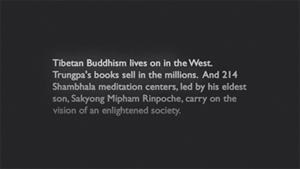
“Crazy Wisdom” was made with a purpose in mind – to cover over the ugly edifice of Trungpa’s transgressions with a façade of holy achievements. To accomplish this, history has been doctored. Important people, both victims and perpetrators, have been removed from the frame, and traumatic events expunged from the record. Trungpa’s own actions have been edited to remove evidence that he exploited his students for sex, seducing female students and cuckolding their mates, amassing money and authority for personal aggrandizement, surrounding himself with fawning servants and uniformed toadies, neglecting his children while procuring for them useless titles of sanctity that merely inflate their pride to no purpose, and recklessly indulging in behavior that destroyed both his mind and body. Simultaneously, the movie elevates the reputations of his close students, who now have established careers as meditation teachers that are founded on the illusion of Trungpa’s own spiritual legitimacy. “Crazy Wisdom” is religious propaganda to shore up a cult of personality, and a marketing campaign that Trungpa’s followers hope to keep going for generations. To use a phrase well-known to his students, it is pure “spiritual materialism.”